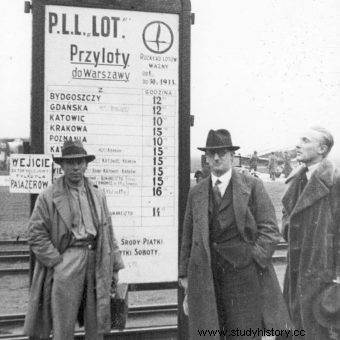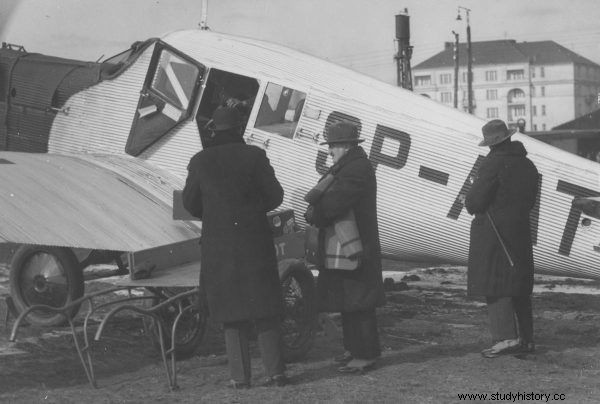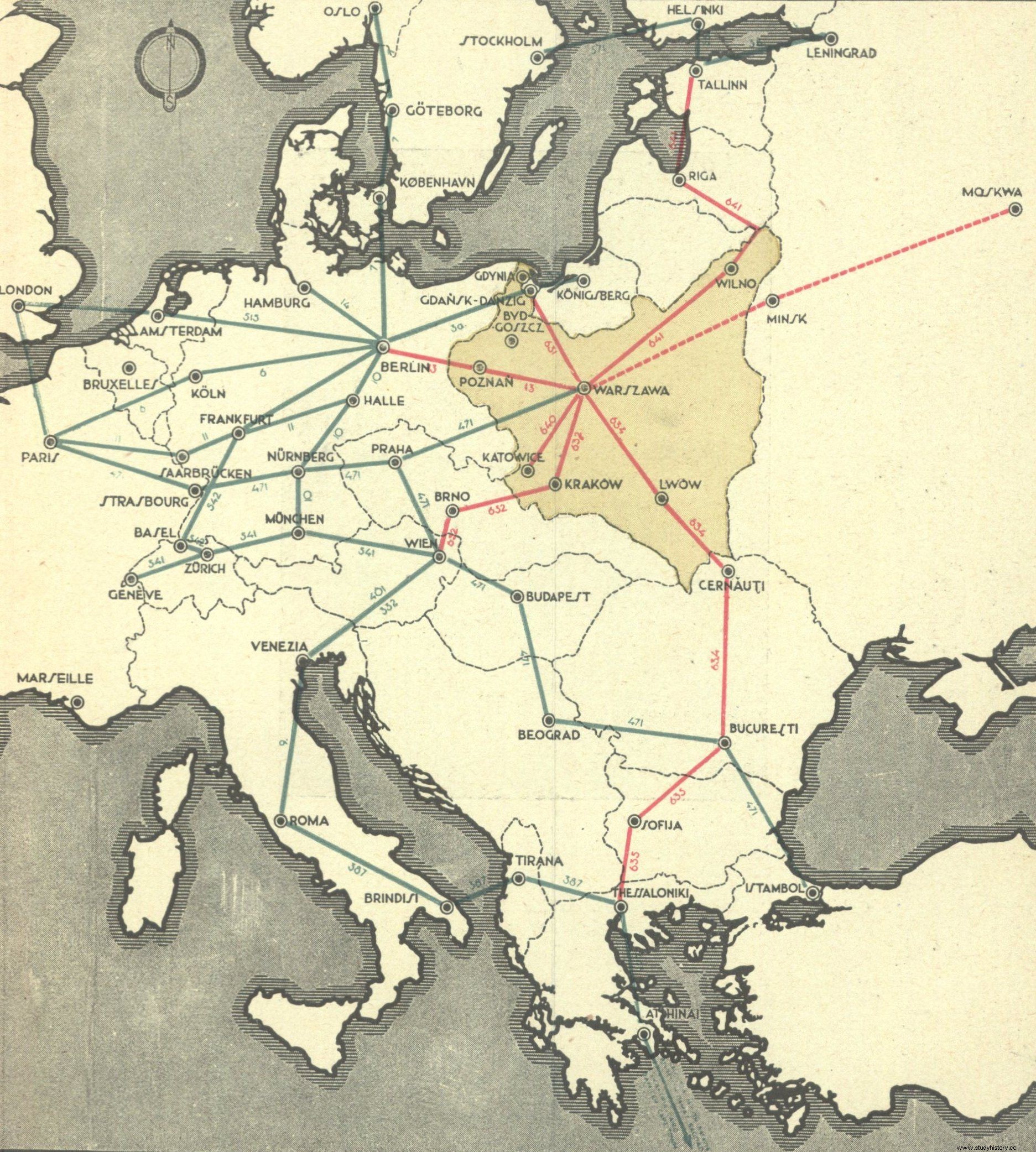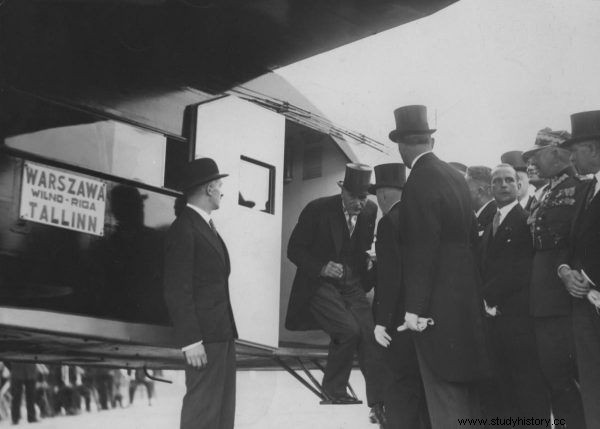Crazy expensive or amazingly cheap? How much did the plane flight cost in the Second Polish Republic? Who could afford it, what were the lines and where did the planes land?
The history of passenger aviation in Poland dates back to 1921, when the French International Aviation Communication Society received a license to launch the Prague - Warsaw line. The following year, the Ministry of Transport granted a permit to a group of people associated with the Polish oil industry to open a line from Lviv through Warsaw to Gdańsk. This is how the "Aerolloyd" company was established, later renamed "Areolot".

Passengers are facing the timetable. Warsaw 1933.
The interest in sky-high travel was considerable and in 1923 the Warsaw - Krakow line was launched, and from 1925 it was possible to fly from the city of Krak to Lviv. At the same time, the first domestic international connection from Krakow to Vienna appeared.
The growing demand for fast travel across a country where the condition of the roads cried out to heaven for vengeance made another player appear in 1925. It was the aviation company "Areo", established on the initiative of the Poznań local government. This is how the connection between the capital of Greater Poland and Warsaw was created. Optionally, also with Berlin, if it was possible to reach an agreement with the German government (it only happened in 1934).

Passengers before the plane takes off from Poznań to Warsaw. 1931.
There were no pears in Silesia either. However, before another company was established, the authorities in Warsaw decided to centralize and establish the state-self-government LOT Polish Airlines, which started operating on January 1, 1929. At the same time, "Areolot" and "Areo" were liquidated.
Establishing a company with state-owned capital provided a large injection of cash, which translated into the purchase of modern aircraft and the launch of new connections. As a result, by the mid-1930s, LOT passengers could fly from Warsaw to Gdańsk, Katowice, Kraków, Poznań, Vilnius and Lviv. As for international connections, machines with a crane on a ballast landed in Berlin, Brno, Bucharest, Riga, Thessaloniki, Sofia, Tallinn and Vienna.
Pre-war flight prices
And how much did the sky voyages cost? You can find out about it by reading Polish Air Communication Guide and Flight Schedule from 1934. According to the price list, the flight from Warsaw to Krakow cost PLN 35. In turn, the trip from the capital to Poznań had to be paid 11 zlotys more. If someone dreamed of a flight from Vilnius to Katowice, he had to spend 70 zlotys, and if a Lviv inhabitant wanted to visit Vileyka, it would have cost him 85 zlotys. For the same money, he could fly to Gdańsk.

Map of air connections from 1934. Those operated by LOT in red.
If someone was not satisfied with flying in the Polish skies, then for PLN 40 he could fly from Krakow to Brno (from Warsaw PLN 75). A trip from the Polish to the German capital was associated with an expense of 105 zlotys, while a trip to Thessaloniki cost a Varsovian 280 zlotys. A Poznań man dreaming of the Greek sun had to reach even deeper into his pocket, because he would have paid 325 zlotys for a ticket.
The cheapest connections in Europe?
LOT authorities boasted that the prices of air connections in Poland were the lowest in Europe, but could the "average" Kowalski be able to afford them? To answer this question, let's turn to the earnings statistics. It shows, for example, that in 1934 a miner received an average of PLN 1.01 per hour of work. However, it should be remembered that it was well paid. Another thing is the textile industry, where the worker received only 66 groszy, not to mention the timber industry, where the average hourly wage was only 38 groszy, which was just over 18 zlotys per week.
If not the workers, then maybe at least white-collar workers could take advantage of the benefits of fast travel? Most of them also had to live with the taste, because over 45% of them earned less than PLN 180 per month, and nearly 80% earned less than PLN 360.

Ignacy Mościcki visits the plane that will operate the newly opened line from Warsaw to Tallinn. 1932.
There are no exact conversion factors, but it is often assumed that the pre-war zloty is equal to 10-15 today's zloty. This would mean that the prices of flights in today's money would range from PLN 350 to PLN 690 for short domestic flights, to PLN 2800-4875 for the longest operated international routes.
Is it expensive? Certainly not for the chairman of the Central Board of the Polish Industry Association "Lewiatan". Before the war, Andrzej Wierzbicki received a salary of 32,000 a month. Bagatela - some 320-480,000 zlotys today ...
Bibliography:
- 20th anniversary of communication in reborn Poland , edited by Stanisław Faecher and Stanisław Peters, Kraków 1939.
- Zbigniew Landau, Jerzy Tomaszewski, Economy of interwar Poland , vol. III, 1930-1935 , Warsaw 1982.
- Concise Statistical Yearbook 1938 .
- Air Communications Guide and Flight Schedule. Summer 1934 , Warsaw 1934.
